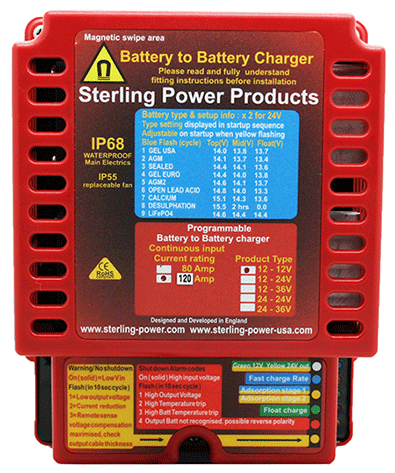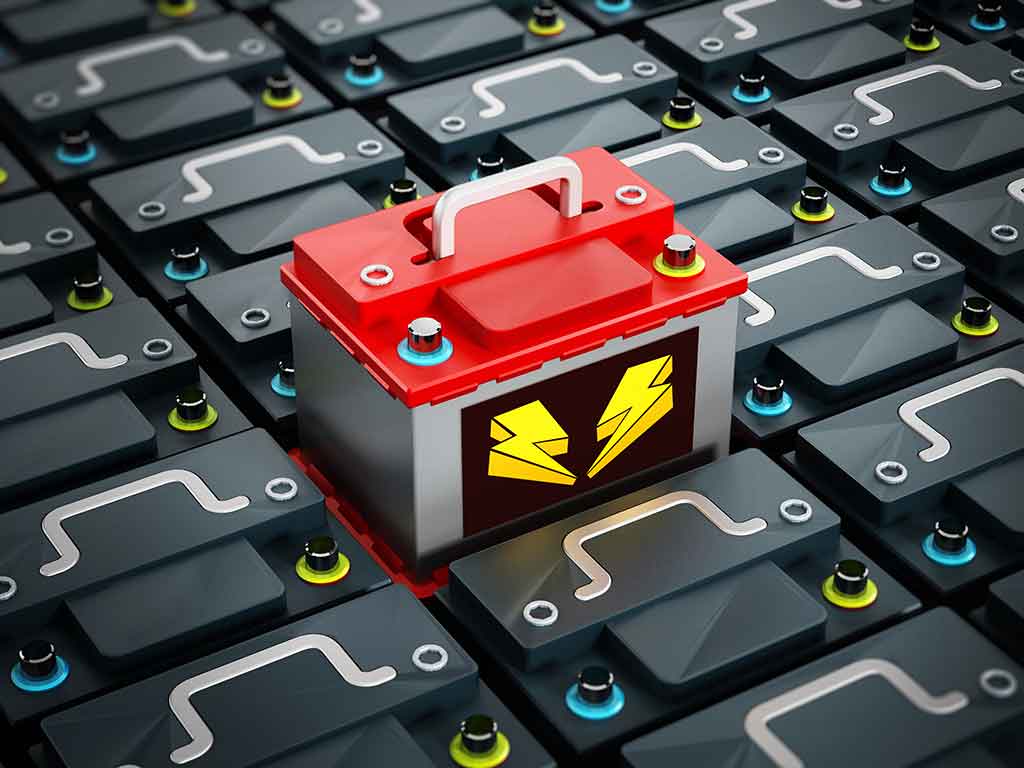EDDIE ‘VANBITZ’ JONES DISCUSSES LITHIUM
LOTS OF OPINIONS ON THIS ONE SO WE THOUGHT WE’D ASK EDDIE JONES OF VANBITZ, FIRST, WHAT HE MADE OF THE RUSH TO INSTALL LIFEP04 AND WHAT HE THOUGHT ABOUT STRAIGHT SWAPS, LEAD-ACID OUT, LITHIUM IN

I would just like to state that I am not a chemist, although I feel I should be, after reading all there is to read about Lithium, how is it made, is it safe and why does it on the surface simply seem to be the universal power panacea for motorhomes and boats? But I am not I own a business that supplies and installs Lithium Batteries, and it is a learning curve for us all!
I started my working life for the Long-life Tyre and Battery Company in the Newton Abbot branch some forty years ago, as the junior which meant I got all the horrible boring jobs, like actually making batteries!
We literally had everything in stock to make most batteries. A customer wanted a battery for his TR6, one would be taken from the rack, and I would be sent out to the battery room to make another one.
The instructions were quite simple! Get the case, get the lead plates, slot the required number in, solder the plates using a massive red hot soldering iron, pop on the lid, seal the lid to the case with heated Bitumen, then fill with a mix of Sulphuric Acid and distilled water and then charge!
Looking back, we were extremely cavalier about both our personal safety, and the safety of the building, charging and soldering and storing all the materials in one room. Perhaps that is the reason that I ended up in the Royal Eye Infirmary in Plymouth, but that is another story, perhaps for another day.
Batteries in those days were lead plates in acid. There simply was not any other option! But since then, there have been amazing advances in battery technology, none as revolutionary as the “new kid on the block” Lithium!

Lithium has been around for some time, watches, cameras & phones to name but a few, but slowly the technology has arrived, the costs have come down and thanks to Lithium Iron phosphate (LiFePO4) access to the unarguable benefits of these “super batteries” is now in fingertip reach of anyone. The reason that I explained the “early” days in batteries is to show in one working lifetime just how much has changed.
I own a business where we sell and install electrical equipment and yes, we stock and sell Lithium batteries from three different manufacturers, and to save lots of crossing the “T’s” and dotting the “i’s” I am only going to be talking about LiFePO4 batteries.
None of the batteries that we sell are a “guaranteed” drop-in replacement for a conventional leisure battery as frankly, I do not believe that such a beast exists, perhaps it may never exist, who knows, but I am not about to bet my business’s reputation that we can simply sell you a Lithium battery and “that’s that”.
To understand my argument, we need to look at what the advantages a Lithium battery set up offers us, the motorhome owner, and how these advantages can benefit us.
In my mind, there are enormous advantages of Lithium batteries and only one disadvantage.
Cost! I am going to duck out of this one as frankly, I do not see it as a disadvantage. If someone is on a tight budget, don’t buy Lithium, let’s face it if your budget is tight, you could look around and get a conventional 100 ah lead acid leisure battery for under £70, I know as I have just Googled it whilst writing.
So, budget to one side, as I am sorry but not every decision that people make is based on cost as its number one deciding criteria. We could argue that if cost was the all important deciding factor, we would all be driving the cheapest entry level motorhomes. Actually, take that argument even further, we would discount motorhomes, miss out caravans and all go camping in tents!
So, people decide to buy Lithium’s like many things not necessarily cost, so I am pushing that to one side as a disadvantage, as it is only a disadvantage to some. Unpalatable? Possibly, True? Definitely.
So, what are the primary advantages of Lithium? Weight, speed of charge, depth of discharge, longer life span, no maintenance, to name a few.
Looking at these in a little more depth, I will use our (my wife Lyn and I) camper as an example. Our penultimate camper weighed in at about 11 tons and payload was never an issue, neither was battery power. With a thirty-odd foot motorhome, space and payload rarely raise their inconvenient head, so having 6 x 135ah gel leisure batteries power was never an issue. In 2018 we ordered a Thor (Owners of Hymer and many other converters) Windsport 27b which weighs in at circa 6 ton so shorter and much lighter.
So, we knew even before we took delivery that we would have an issue battery wise. Less locker space and a desire to keep the van under the 7.5 Ton rating meant that we were looking at payload differently for once. In the battery locker, there were two 110ah batteries, each weighing about 30 Kg.
We had a potential of 220amps usable power for a weight of 60Kg, but of course, we didn’t. As most of you will know, with a lead-acid battery you really should only look at discharging the battery to about 50% total capacity.
Now as my staff explain to our customers when they call from time to time worried that they have exceeded this, this is a “Guideline” rather than a rule, something to aim at if you wish to get the best from your battery over the longest time, so if occasionally you go “power-mad” and discharge them a bit deeper do not worry.
We had a “usable” capacity of 100amps. However, when we replaced the conventional lead-acid batteries with AL100 Sterling Lithium batteries, we can access 100% of the battery’s capacity, so doubling the actual, usable power available to us, that in itself would be a remarkable benefit, but we straight away get two other massive benefits that made it an easy decision.
Weight! At circa 15Kgs two of the Sterling Lithium batteries weighed pretty much the same as one of the conventional lead-acid batteries that we had removed, so doubling the usable power and halving the weight, with a net gain in payload of 30Kgs!
Add to this that the Lithium’s are maintenance-free, and unlike lead-acid batteries that either have to have the levels checked regularly which is a pain, or sold as “sealed” which simply means that they are overfilled and have an expected short lifespan, with the manufacturers relying that people will forget to, or not bother making a warranty claim, true “no maintenance is a genuine real bonus!
Now, luckily for me, the camper has a high output alternator and came with a decent on-road charging system factory installed, but many motorhomes do not have this benefit.
Just to look at this for a moment, as many people will know the term “split charging” but just in case anyone thinks a ‘Split charge’ system is a clever or wondrous thing! It is just an inexpensive relay that ‘closes’ as soon as the engine starts, simply joining the engine and the leisure batteries together, via an all too often skinny wire. This applies even if your relay is in an expensive-looking box
Think Sargent, CBE and Schaudt and then think back to when we all had stereo equipment and think Amstrad and Technics for ‘stack systems’ opposed to separate units such as Bang and Olufsen and Bose. If you could afford it, you would buy separate units, each doing its one job very well. If like me, you were skint all the time, you’d but a “Technics” unit. It looked like a stack of separate units, but it wasn’t and listening to it proved it!
People often say to us “Hymer wouldn’t fit them if they weren’t any good” and we answer that we’re not saying that they’re no good, just that they’re designed for the ‘average’ person to use their motorhomes in the ‘average’ way IE lots of sites and hook-ups. But, if you intended to spend most of your time on hook up, you really do not need to be spending your money on buying Lithium batteries though.
So, I was delighted that my van has a substantial (actually 160 amp) on road charger, often referred to as a Battery to Battery charger, and not a split charger, why?
Well, yet another of the amazing benefits of Lithium batteries is their ability to re-charge, their desire to simply suck energy in, which makes for the ultimate “use and replenish” power source! And that brings me to the nub of my arguments about “drop-in” replacement lithium batteries.
If you look in your motorhome handbook and look at the “fuses” section, you will probably see that your battery charging or split charge fuse is rated at circa 20 amps. That means that no one is expecting you to be able to charge your leisure batteries at more than that. Then, have a look at the big thick wire that runs from your alternator to your engine battery, thick and quite short!
Then look at the wire that is connected to the leisure battery positive, you find that it’s quite skinny, often about the same diameter as a bootlace, and all too often, metres away from the engine battery.
All too often in these scenarios, there is little real chance it will properly charge the leisure battery once the engine starts! Hence the 15 or 20 amp fuse in the system!
So, what does this actually mean? In short, again using me as an example, my AL100 batteries with accept a 50 amp charge without being damaged. I have two AL100’s so if I can supply a 100 amp charge my Lithium batteries will be able to soak that charge up and will not be damaged by it.
I get up in the morning and use the inverter to power things (normally my wife’s hairdryer) and let’s just say that we have used 50% of our available capacity 100 amps. When we are ready to leave, if we drive for one hour to our next destination, our batteries are pretty much fully charged again!

If I had a split charge system that could work at the maximum fuse rated capacity (which of course it can’t in the real world) so say 20 amps, I would need to drive for FIVE hours to achieve the same result! An enormous difference
Now, admittedly, most campers are not supplied with an alternator capable of supplying 160 amps to charge the leisure batteries, but the installation of an aftermarket B2B which is rated at about 60 amps is entirely sensible and feasible.
Many Lithium battery suppliers will claim that their battery is a “drop-in replacement” and then it is “mentioned” in the small print where suitable equipment is already installed!
I have no doubt that if you bought a 2021 motorhome, that because of regenerative breaking alternator issues brought in because of emission controls on Euro6 chassis (another side issue for another day) that a suitable B2B system will be fitted by the converter. Again, it is unlikely on a 2021 motorhome that the converter fitted “mains charger” will not have a Lithium profile, after all why would you manufacture a mains battery charger for a motorhome, caravan or boat that was unsuitable for Lithium batteries, the same goes with Solar panel regulators.
However, if you have a 2010 motorhome, and you’re trying to get your head around Lithium, and you’re trying to save some money and you read about a Lithium battery that should be a “drop in replacement” (terms and conditions apply) it is a totally different ball game.
If you’re hoping to spend more time off-grid, and you want to be more independent and stay at more remote places, or as many of our customers want to do, be able to run a decent-sized inverter without compromising all the time, Lithium is great, but, if you are going to have to run back to civilisation every second day to “recharge the motorhome” you’re not enjoying the benefits of Lithium, which is an expensive mistake.
Three things that you must have right to get the most from a Lithium battery.
A mains charger that has a Lithium profile, normally with a maximum charge of about 14.6 VDC and a float (maintenance) charge of 13.8 VDC.
If it doesn’t have a specific Lithium profile, it was probably designed before Lithium was a “Thing” and may damage your Lithium battery.
BATTERY TO BATTERY CHARGING.
slightly less problematic voltage wise as you will not be driving 24 hours a day, day in and out (a mains charger is on 24/7 don’t forget) but it’s really important to ensure that you’re maximising your engine charging to take advantage of using the Lithium’s amazing ability to recharge using your engine whilst you go from place to place.
And third, a decent solar regulator. If you have some old dodgy solar regulator that your “mate” gave you when he moved, 10 years ago, bin it! Buy a regulator that has a lithium profile, preferably one that is MPPT (Google it) Two reasons for this, decent MPPT regulators put out more charge, they convert it better, and as I keep repeating, Lithium batteries will suck up power so much better than conventional batteries so they devour everything your solar panel can chuck at it when it needs it.
The second reason to bin that old cheapo regulator, Lithium batteries will have a battery management system (BMS) normally built in, sometime externally. The BMS is there to protect the battery, rather than be a day to day “management system” if something happens and the BMS does not like it will shut down, which may then require the battery to be disconnected to reset it, or some reset procedure. Not a problem if you’re there, but really annoying to go out for the day and return to find that because of a voltage spike caused by your solar regulator, your lithium battery(s) shut down and did recharge despite being in the Sun all day and worse; your compressor fridge was turned off and your food is turned and even worse, your Beers are warm!
So, you lay out a lot of money for a Lithium battery that is suitable as a drop-in replacement, but your infrastructure simply isn’t up to it, so you’re not enjoying the actual main benefits of using a Lithium battery so you’re wasting your money.
It’s like buying an expensive sports motorbike and tuning it right down till it’s safe and boring enough to ride to the shops, when you should have bought a Moped.
Eddie Jones



